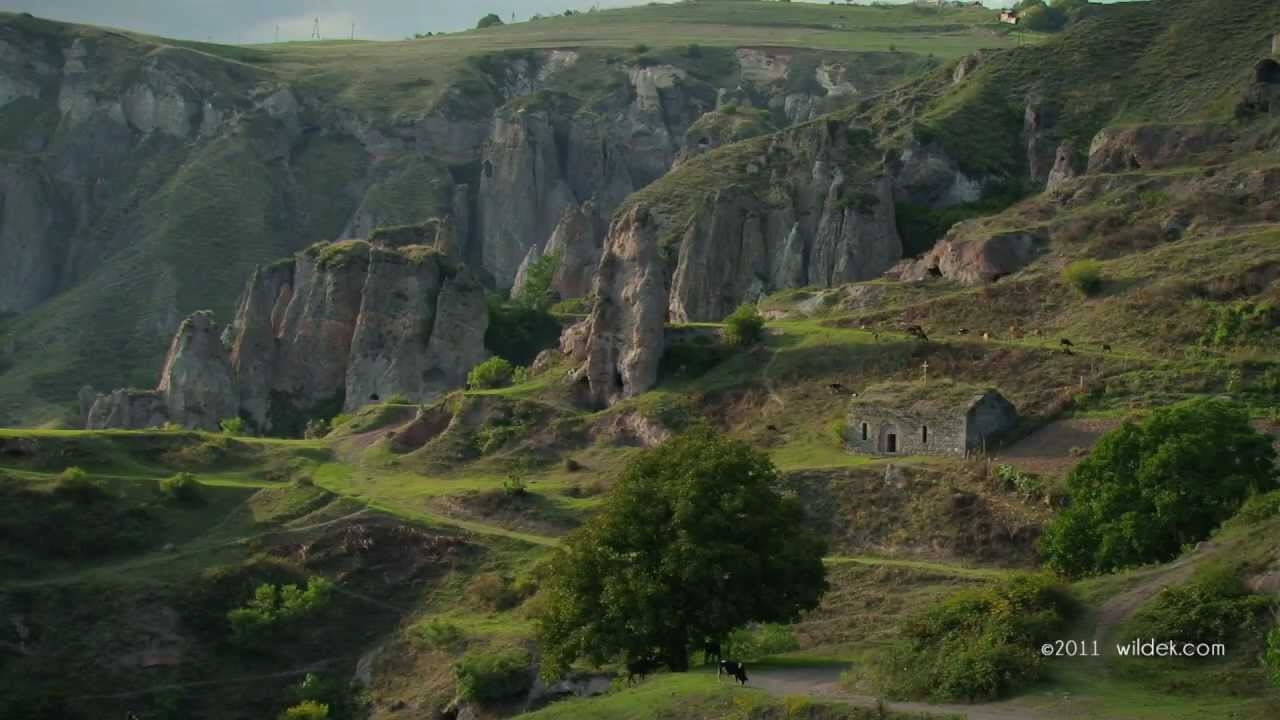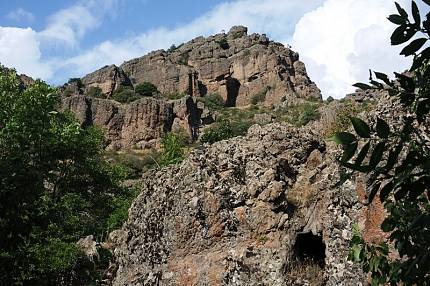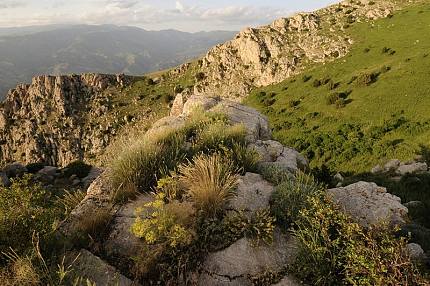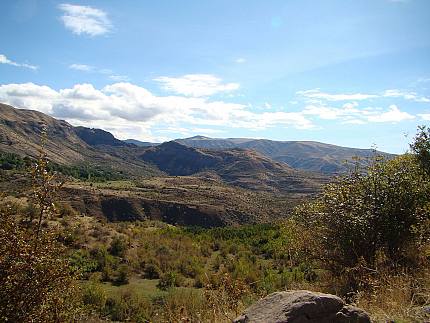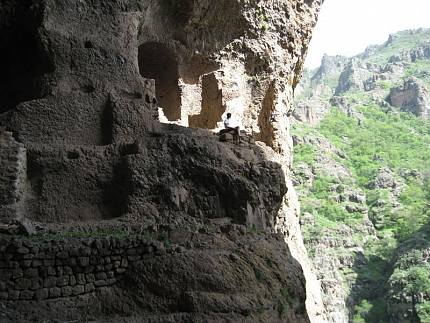Khosrov forest reserve
Khosrov Forest State Reserve is one of the oldest protected areas in the world.
The roots of Khosrov Forest State Reserve are buried deep in history and reach to the 4th century AD, The Arsacid dynasty (known natively as the Arshakuni dynasty) in the times of Khosrov the 3rd Arshakuni. Historic sources say that "Khosrov Forest" expression is associated with the King Khosrov III Kotak (Kotak means small).
Khosrov Forest State Reserve was established in 1958 by the ArmSSR Council of Ministers decision N P-341. The reserve is located in Ararat Province of Armenia in the neighborhood of Ararat valley, on the mountainous ridges Gegham, Yeranos and Yerakh. It occupies a territory of 23213.5 ha at the altitudes from 700 to 2800 m above sea level. The reserve protects juniper and oak forests from Tertiary Period, arid associations of semi-desert and phrygana landscapes and other Mediterranean relict plant ecosystems as well as the genetic fund of rare animals and plants adapted to the reserve conditions. Since 2002, administrative, scientific, practical and organizational activities in the reserve have been implemented by the “Khosrov Forest” State Reserve” State Non-Commercial Organization (SNCO) of the Bioresources Management Agency under the aegis of the Ministry of Nature Protection of the Republic of Armenia.
According to the reserve charter (RA Governmental decision N 925 from 30.05.2002, Annex 1) the main goals of the reserve establishment are to ensure natural development of water and terrestrial ecosystems of the Revers Azat and Vedi basins, to protect the landscapes and biological diversity including the genetic fund of rare and endangered plants and animals as well as their habitats, to implement scientific research and to create prerequisites for the development of scientific-educational tourism, environmental education and responsibility.
The following protected areas are under the subordination of the “Khosrov Forest” State Reserve” SNCO:
- Khosrov Forest state reserve, which at present is divided into 4 districts- Garni (4253 ha), Kaqavaberd (4745 ha), Khosrov (6860.8 ha), and Khachadzor (7354.7 ha).
- Goravan Sands state sanctuary (95.99 ha)
- Khor Virap state sanctuary(50.28ha)
Realizing the importance of the reserve, on August 26 in 2013 “Khosrov Forest” State Reserve” SNCO was awarded with European Diploma of Protected Areas.
The reserve has wonderful landscapes, rich biological diversity, a huge variety of interesting and important untouched forests that are the result of long-term preservation, proper management plan and structure.
Flora
On the territory of the reserve, making only 1% of the whole territory of Armenia there are 1,849 species of high vascular plants, which makes more than the half of the flora of Armenia (more than 3,800 species total) and about 1/3 of the wealth of the Caucasus flora (about 6,000 species total). They are represented in 588 genera and consist of 107 families. More than 80 species are involved in the Red Data Book of Armenia, and 24 species are endemic.
On the foothill and low mountainous zones at the altitudes from 800 till 1200-1300 and sometimes up to 1400 m the wormwood semi-deserts are common. Mountain(ous) steppes, arid sparse forests and oak forests are represented in the middle mountain zone (1400-2200 m above sea level).
Tertiary relict juniper and oak forests are located in the forest zone, which are rather dense in Khosrov and Khachadzor districts of the reserve. Meadow vegetation covers the altitudes from 2100-2200 up to 2600-2800 m.
Fauna
The reserve is well known for the rich diversity of fauna. There are 283 species of vertebrate animals. Out of them more than 58 are registered in the Red Data Book of Armenia and 51- in the IUCN Red List. The most numerous group is birds represented by 192 species, mammals are represented by 44, reptiles-33, amphibians-5 and fish-9 species. 13 species of mammals, 37 birds, and 10 reptiles are registered in the Red Data Book of Armenia and 11 species of mammals, 37 birds and 8 reptiles- in the IUCN Red List.
Large mammals of the reserve are represented by Caucasian leopard, Eurasian lynx, brown bear, gray wolf, wild swine, bezoar goat, hare, weasel, stone marten, badger, Indian porcupine and other species.
Bezoar goat (Capra aegagrus) has been inhabiting the reserve all through the ages. Numerous rock paintings on the territory of the reserve and bezoar goat ornaments of monuments from the Middle Ages are the evidence of its long lasting existence on the territory. Bezoar goat got its name thanks to globular hard formations-bezoars, which are formed in its stomach on the basis of something hard in its food, for example, hair.
The bird fauna of the reserve is rich in species belonging to numerous families. Lammergeyer (Gypaetus barbatus), Egyptian vulture (Neophron percnopterus), Eurasian griffon vulture (Gyps fulvus), Eurasian black vulture (Aegypius monachus), pallid harrier (Circus macrourus), golden eagle (Aquila chrysaetos), lesser kestrel (Falco naumanni), Trumpeter and Mongolian finches (Bucanetes mongolicus, Bucanetes githagineus)different species of Falco and others build their nests in non-accessible rocky niches and caves. It is important that the reserve is the only nesting place of black vulture in Armenia. This rare bird nests on the tops of juniper trees predominantly in Khosrov district of the reserve. Besides the above mentioned species there also occur Caspian snowcock (Tetraogallus caspius), grey partridge (Perdix perdix), chukar (Alectoris chukar), warbler (Sylvia), European hoopoe (Upupa epops), crested lark (Galerida cristata), pale rockfinchand (Carpospiza brachydactyla), Asian crimson-winged finch (Rhodopechys sanguineus), Isabelline wheatear, Finsch's wheatear (Oenanthe isabellina, Oenanthe finschii), Rufous-tailed scrub robin (Cercotrichas galactotes), Menetries's warbler (Sylvia mystacea), black-bellied sandgrouse (Pterocles orientalis), European roller (Coracias garrulus), European bee-eater (Merops apiaster), European honey buzzard (Pernis apivorus), Short-toed snake eagle (Circaetus gallicus), Common buzzard (Buteo buteo), Eurasian sparrowhawk (Accipiter nisus), Northern goshawk (Accipiter gentilis), Booted eagle (Hieraaetus pennatus), Woodlark (Lullula arborea), Lesser whitethroat (Sylvia curruca), Rock bunting (Emberiza cia), Eurasian siskin (Carduelis spinus), Goldcrest (Regulus regulus) many other species of small birds.
In the territory of the reserve there occur the following reptiles: blunt-nosed viper ( Macrovipera lebetina), Armenian viper (Vipera raddei), steppe viper (Vipera eriwanensis), European cat snake (Telescopus fallax), Frontal Asian Mabuya (Trachylepis septemtaeniata), Berber skink (Eumeces schneideri), Aesculapian snake (Zamenis Elaphe), Black-headed ground snake (Rhynchocalamus melanocephalus satunini), Mediterranean tortoise (Testudo graeca), phrynocephalus horvathi, trans-Caucasian racerunner (Eremias pleskei) and many other species.
The amphibians in the reserve are Lake Frog (Rana ridibunda), Asia Minor frog (Rana macrocnemis), Middle East tree frog (Hyla savignyi), European green toad (Bufo viridis) and Syrian spadefoot (Pelobates syriacus).
Fish species occurring in the rivers include Brown trout (Salmo trutta fario), Sevan khramulya (Capoeta capoeta),Kura barbel (Barbus lacerta cyri), bleak (Alburnus filippi), North Caucasian bleak (Alburnus alburnus hohenackeri), Armenian schneider (Alburnoides bipunctatus), Golden Spined Loach (Sabanejewia aurata), Angora loach (Nemacheilus angorae), Bearded stone loach (Barbatula barbatula caucasica).
The invertebrates of the reserve are represented by more than 1.500 species, out of which 62 species are molluscs, 3 species are scorpions and 1.427 are insects species.
The reserve territory is rich in historical and cultural monuments. Havuts Tar and Aghjots Saint Stepanos monastery complexes, Mankuk, Aghasi, Khosrov, Spitakavank, Geghmahovit, Berdatak, Avanik (Small Shen), Vanstan, Gilan villages, Kaqavaberd which is also known as Geghi fortress, Astghik and Vahagn's Waterfalls, hundreds of cross-stones or khachkhars, medieval bridge and other historical monuments are located in the territory of the reserve.
The cozy corners of Khosrov keep the first human cultural development imprints (engraved rock images, traces of ancient civilization, archaeological monuments and sites of historic and cultural great value).
There is a free museum in the administrative building of the reserve in the town of Vedi, where one can get familiar with flora and fauna of the reserve.
Unique nature, historic-architectural monuments, rich diversity of flora and fauna provide a basis for perspective development of ecoturism.
The reserve has two visitors’ centers, one of which is located in Garni, and the other one in Khosrov district."Khosrov Forest" State Reserve is unique not only in Armenia, but also in the whole Caucasus ecoregion.


